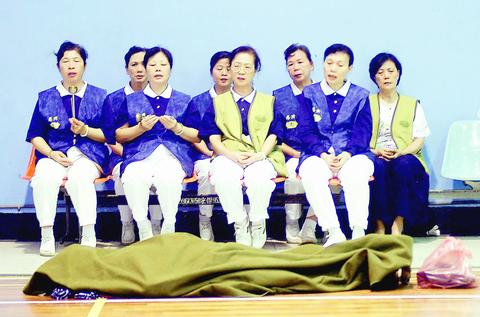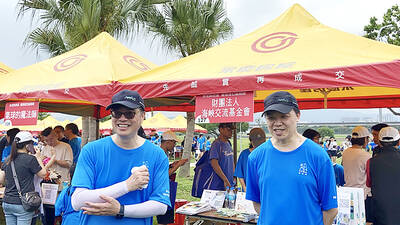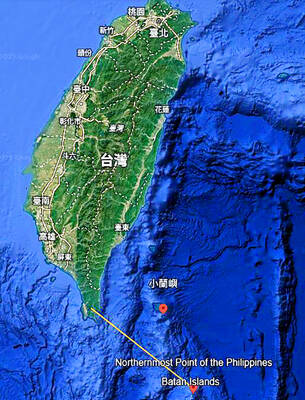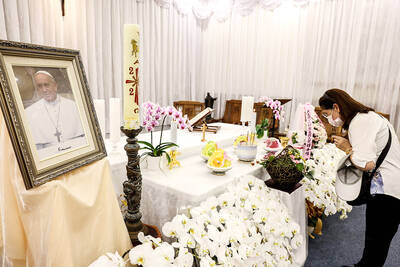China Airlines flight CI 611 with 225 people on board crashed into the sea near Penghu yesterday afternoon after taking off from Taipei en route to Hong Kong.
The search-and-rescue effort was still underway and no survivors had been discovered as of press time last night. More than 100 bodies have been spotted, according to a China Airlines spokesman.

PHOTO: CHANG CHIA-MING, TAIPEI TIMES
The cause of the crash is still under investigation.
The Boeing 747-200, which took off from CKS International Airport at 3:08pm, disappeared from radar screens at around 3:30pm, when it was about 19km from Makung city, officials said.
According to China Airlines' records, the plane was carrying 206 passengers, three of whom were infants, and 19 crew members.
All 19 crew members as well as 190 passengers on board were Taiwanese, including two United Daily News reporters and a former legislator.
In addition to 14 Hong Kong, Macau and Chinese residents, foreign passengers also included one Singaporean, identified as Sim Yong-joo, and one Swiss, identified as Luigi Heer.
The air force and coast guard sent ships and helicopters to search for the plane as soon as the accident was reported, with the first body found at about 6:14pm around the port of Chihkan, located north of Penghu Island.
The Executive Yuan established an emergency command center headed by Minister of Transportation and Communications Lin Lin-san (
Showing his concern about the accident, Premier Yu Shyi-kun went to the airport in the afternoon and then rushed to the Civil Aeronautics Administration office last night to take command of the search-and-rescue efforts in person.
"This is a matter for regret," Yu said.
Yu said President Chen Shui-bian (陳水扁) had ordered the military to mobilize all possible resources to search for survivors, as long as the nation's combat readiness was not impaired.
Vice Minister of Transportation and Communications Chang Chia-juch (
Chang added that the control tower had not received any distress calls before the plane went missing.
Data indicate that the crash took place between 3:37pm and 3:40pm, when two Cathay Pacific planes in the vicinity received emergency location-indicator signals from the downed China Airlines plane, Chang said.
The Executive Yuan's Aviation Safety Council created an investigative panel last night to look into the cause of the accident.
Kay Yong (戎凱), managing director of the council, who also serves at the panel's chief investigator, said the council has contacted the US' National Transportation Safety Board and Boeing Company to help with the probe.
China Airlines officials, meanwhile, bowed and apologized to the bereaved families for the terrible air disaster.
A number of agitated relatives of the passengers rushed to the China Airlines office in Taipei to gather information related to the crash, and were upset with the company's failure to immediately provide them with details.
China Airlines Senior Vice President James Chang (
"We are regretful for such an unfortunate accident and we would like to pay our gratitude to the government for assisting with the recovery," Chang said.
With the assistance of China Airlines, around 200 relatives of the passengers flew to Makung last night to identify the bodies.
This has been the 14th air crash involving China Airlines since 1969, official statistics indicate. The company's notorious safety record once put it on the list of the world's most dangerous airlines.
The last known fatal China Airlines accident was a crash-landing in Hong Kong in 1999, killing three people.
Over 200 people were killed respectively in the 1994 crash in Nagoya and the 1998 crash in the Taoyuan in the vicinity of CKS International Airport.

SECURITY: As China is ‘reshaping’ Hong Kong’s population, Taiwan must raise the eligibility threshold for applications from Hong Kongers, Chiu Chui-cheng said When Hong Kong and Macau citizens apply for residency in Taiwan, it would be under a new category that includes a “national security observation period,” Mainland Affairs Council (MAC) Minister Chiu Chui-cheng (邱垂正) said yesterday. President William Lai (賴清德) on March 13 announced 17 strategies to counter China’s aggression toward Taiwan, including incorporating national security considerations into the review process for residency applications from Hong Kong and Macau citizens. The situation in Hong Kong is constantly changing, Chiu said to media yesterday on the sidelines of the Taipei Technology Run hosted by the Taipei Neihu Technology Park Development Association. With

CARROT AND STICK: While unrelenting in its military threats, China attracted nearly 40,000 Taiwanese to over 400 business events last year Nearly 40,000 Taiwanese last year joined industry events in China, such as conferences and trade fairs, supported by the Chinese government, a study showed yesterday, as Beijing ramps up a charm offensive toward Taipei alongside military pressure. China has long taken a carrot-and-stick approach to Taiwan, threatening it with the prospect of military action while reaching out to those it believes are amenable to Beijing’s point of view. Taiwanese security officials are wary of what they see as Beijing’s influence campaigns to sway public opinion after Taipei and Beijing gradually resumed travel links halted by the COVID-19 pandemic, but the scale of

A US Marine Corps regiment equipped with Naval Strike Missiles (NSM) is set to participate in the upcoming Balikatan 25 exercise in the Luzon Strait, marking the system’s first-ever deployment in the Philippines. US and Philippine officials have separately confirmed that the Navy Marine Expeditionary Ship Interdiction System (NMESIS) — the mobile launch platform for the Naval Strike Missile — would take part in the joint exercise. The missiles are being deployed to “a strategic first island chain chokepoint” in the waters between Taiwan proper and the Philippines, US-based Naval News reported. “The Luzon Strait and Bashi Channel represent a critical access

Pope Francis is be laid to rest on Saturday after lying in state for three days in St Peter’s Basilica, where the faithful are expected to flock to pay their respects to history’s first Latin American pontiff. The cardinals met yesterday in the Vatican’s synod hall to chart the next steps before a conclave begins to choose Francis’ successor, as condolences poured in from around the world. According to current norms, the conclave must begin between May 5 and 10. The cardinals set the funeral for Saturday at 10am in St Peter’s Square, to be celebrated by the dean of the College